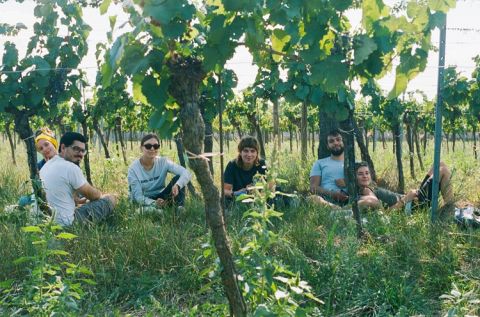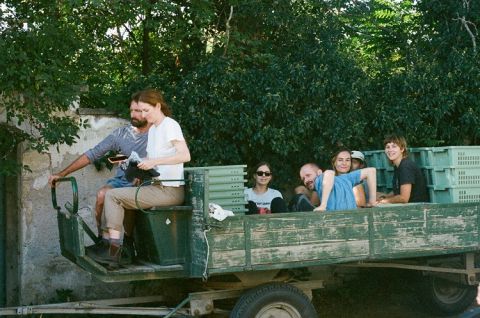Many wines have names, Bertholdi is special because he also has a face. He is a charming and wise gentleman but sometimes when he is not in a mood can be rather grumpy. From time to time he shuts down and asks to leave him alone. This is his story.
Austria in general and Burgenland, in particular, are not famous for old vines but as always there are exceptions. The vines for Bertholdi were planted in 1953. When Stephanie Eselböck-Tscheppe and Eduard Tscheppe bought the winery in the sleepy village of Oggau in 2007, the property was abandoned for a decade. So were the vineyards. The previous owners had a good reputation for their wines but there were no bottles left as a reference. So the couple started everything from scratch.
Eduard assumes that the financial difficulties of the previous owner saved these vines from uprooting. Usually in Burgenland growers replant vines every 30 years. The main reason is productivity which drops significantly. Other is esca, a fungus killing the trunk of the vine, which is ravaging nowadays many Austrian vineyards. Also, in the 1980s and 1990s, the international grape varieties came into fashion, so local Furmint, Welschriesling and Blaufränkisch were changed for trendier Chardonnay, Merlot and Cabernet Sauvignon. Bertholdi was luckily saved by the unluckiness of its owners. They just could not invest in replanting.
So, in 2007 the vineyard started a new life. The plot is around 0,4 ha close to the village of Purbach. It never had a special name as the local tradition always implied blending of different plots. The “Weingarten” was in general in a good condition. There were few empty spots here and there where vines had died but most of the plants were healthy and vital.
Gut Oggau usually do not normally emphasize the grape varieties in their wines, giving the priority to terroir. Most of their wines are blends of different grapes. But Bertholdi is again special. It is a single vineyard wine. Bertholdi is Blaufränkisch, The Burgenlander. It is an ancient grape, believed to be the progeny of the famous vine Casanova, Gouais Blanc. With this parentage, Bläufrankisch is a close relative of Pinot Noir and Chardonnay.
The soil here is a curious mixture of limestone, slate, and even some quartz. The topsoil is sandy and poor. The slope provides good drainage, regulating water availability and vine vigour.
The vines are grafted but Eduard highlights that they are hand-grafted. In 1953 modern technologies were only emerging, so growers did a lot by hand. Today in the nurseries scion and rootstock are normally connected by machine. It is much quicker and more efficient but the risk of propagating diseases to a large number of vines is high. These old, hand-grafted vines probably survived that long as they were initially free of viruses and fungi. We don't know which clones and rootstocks were used. Probably, quite productive ones. It was common in post-war Europe. The main goal was to revive agriculture and restore food supplies. Though with age the Bertholdi vines have regulated themselves and now the production is tiny, around 12 Hl/ha.
“Bertholdi has a gentle slope, nothing compared to Mosel or Douro”, says Eduard. It could be a good encouragement for the workers! Because working there is hard. The vineyard is still quite steep, so it is always a good cardio exercise when one is going uphill spraying the biodynamic preparation from a heavy copper knapsack.
The Bertholdi vineyard is always the last to harvest. The proximity of the lake extends a lot the growing period. In 2020 we harvested it in early October. Those who have visited the place in autumn have seen these endless flocks of birds. Sometimes they implied some irrational, probably Hitchcock-inspired fear on me. And they love grapes! So, when grapes start to ripen and accumulate sugar they become a daily snack for the birds. To protect the vineyards, thousands of meters of nets are installed all around the Neusiedlersee every year. Nets are efficient but time- and labour-consuming and after harvest, they need to be removed. Believe me, Bertholdi requires a lot of hours of work.
Harvesting for Bertholdi is a real gym. Some of the vines are low, so the team is naturally divided between squat fans and bend lovers. We were lucky that our group of enthusiasts was supervised by a team of experienced Hungarian workers, all in their 60s. I was admiring how these people were doing their job: always quick and efficient but chatting and joking non-stop. They taught us a trick: one should start harvesting a steep vineyard from the top and move downwards, it saves a lot of energy.
The grapes for Bertholdi are never destemmed, they go directly to the barrel for fermentation. In the early vintages, Stephanie and Eduard favoured a longer maceration, now they changed their philosophy and are looking for a finer, less extracted style. Later the wine is slowly pressed with an old wooden basket press which allows very gentle oxidation. Eduard believes that "wine and oxygen are friends". This exposure to oxygen at the beginning allows making "timeless wines" which can live for decades. Bertholdi is aged for around 18 months in a 500L neutral barrel and then 6 months in a bottle before release. This barrel is the whole crop of the year, around 650 bottles.
The wine is deep and concentrated but not in alcohol or body. It is more about structure, the substance that the French call “matière”. It is never “in your face” and needs time in a glass. Eduard says that from time to time guests come with early vintages of Bertholdi to taste together. These bottles from the late 2000s are still fresh and bright and have a long life ahead.
Finally, I asked Eduard how many years more, he thinks, the Bertholdi vineyard will live and breathe? He was rather puzzled. In a way thinking about it is like calculating when your close relative passes away. Even with some mending with younger plants here and there, the old vines of Bertholdi have a bright future ahead. Orgulous and robust, they face their 68th year.
Photo credit: Georgina Best and Gut Oggau
















